You’re here! And that means that you’re getting close to making a big life decision. You want to start an online business. It could be an ecommerce business, a service-based business, a coaching or course-based business, or something else. But the biggest question you probably have is — what do I do? To get you started, we’ve created a complete checklist for starting an online business.
Maybe you’re tired of working for someone else, want to set your own schedule, or are done having no control or influence over your salary. You’re excited about taking a risk and seeing what you can build based on a business or product idea. Maybe it’s all of the above.
Whatever has led you to consider starting an online or ecommerce business, it’s going to take some work, and you’ll need guidance.
The good news is, you don’t need a college degree to become a successful business owner. Anyone who is willing to work, learn, take risks, and follow through can make this happen.
But, there is a lot to do, and that’s why having an online business checklist will be so helpful. WooCommerce works every day to democratize commerce, providing opportunities for everyone to pursue their ideas regardless of where they are, who they are, and what resources they have. Helping people succeed in commerce is what we do!
Table of contents
- Common questions from new business owners
- How much does it cost to start an online business?
- How long does it take to get started?
- How long does it take to launch an ecommerce website?
- Can I start an ecommerce business with no experience?
- Can I start an online business on a tight budget?
- Is it a good idea to start an ecommerce or online business?
- What do I need to know about starting an online or ecommerce business?
- The ultimate online business checklist
- Grab your checklist and start working through it today
Common questions from new business owners
We’ll get to the checklist for starting an online business in a bit, but first, let’s address some questions about starting an online business.

How much does it cost to start an online business?
Starting an online business costs considerably less than a traditional business with a storefront or production facility. However, there are a number of costs you’ll still need to factor in before you get started.
First, you must prepare and launch your website. You can save costs by doing some of this on your own by creating your own website content and building your ecommerce business on a free platform such as WooCommerce. Or, you can save time and pay a freelancer or agency to do it.
Next, you’ll have some legal costs, such as business licenses, permits, and possibly writing legal disclaimers depending on your products. If you rent equipment, you may want a rental agreement drafted by a lawyer.
Another business cost is for accounting services and tax preparation, including paying sales tax. And you’ll pay shipping costs if you sell a physical product, which can also include returns.
So, even with an online business, there will be startup costs.
And if you’re starting an ecommerce business that sells physical products, you’ll have the additional costs of product development, manufacturing, and inventory.
How long does it take to get started?
For online businesses that don’t sell physical products, such as a coaching business or a service-based business like copywriting or web design, you can get started in a matter of weeks.
If you can devote several hours per day to your new venture, knocking off items on your online business startup checklist, you can be open much sooner than you think.
Working with physical products can add a few weeks, or even a number of months, to this process. If you’re manufacturing or customizing your own products in-house, you’re only limited by the time it takes to receive raw goods and complete your projects. Working with manufacturers or other third parties adds development and shipping time to the process.
As with anything, if your new business is a side project, the time you have to devote to development will limit how quickly you can launch. Sometimes, finding the best online business to start is the biggest hurdle. From there, you can gain momentum and get things running quickly.

How long does it take to launch an ecommerce website?
For ecommerce businesses with products, packaging, and related requirements, startup times will be longer. Setting up the ecommerce website is really one of the last steps to opening for business. Why? Because you need to have your products and processes determined first.
What are you selling? Where is it being made? What will the packaging look like? How are you procuring your inventory — are you managing it yourself or using a dropshipping strategy? What are your product categories? Do you have different flavors, sizes, or colors? Add-ons and options? Customizations?
What shipping options do you need to provide? How does your target audience prefer to pay?
Once you have everything in development, you can think through and outline the pages your site will need and the functionality it must include.
Creating and organizing all of the content for your site — product photos, descriptions, FAQs, etc. — can take a while. But having these things lined up before you hire a freelancer or agency can make the process go much more quickly.
An experienced web designer can create a simple ecommerce site in a few days. However, you should expect the process to last several weeks or so for an average store. If you’re building something more complicated or don’t have all of your content and functionality needs organized in advance, building an ecommerce site can take a few months or longer.
Can I start an ecommerce business with no experience?
Your learning curve will be steeper, but as long as you’re persistent, yes it’s totally possible!
If you have no experience, it’s wise to budget some extra money up front to educate yourself about how to sell online.
You don’t need a formal degree, but taking some online courses can shorten your path to success. Sometimes, it’s worth a small investment to learn from an expert or two. Why? Consider just some of the tasks you’ll have to fulfill:
- Understanding marketing
- Writing an online business plan
- Learning how to sell
- Writing good product descriptions
- Providing customer service
- Writing web content
- Acquiring leads
- Figuring out manufacturing and inventory management
- Developing a mindset for success
Can I start an online business on a tight budget?
Yes you can, but you’ll likely trade out-of-pocket expenses for speed. If you’re good at teaching yourself new things and have the motivation to do so, you can learn the basics of website architecture, copywriting, design, business structure, and marketing on your own time.
Hiring experts to help with these things can speed up the process, but requires financial resources up front.
A good plan is to work on your ecommerce or online business during your off-hours, as a side business, and build it a little bit at a time. You won’t regret the time you spend educating yourself, because in the end it will produce more knowledgeable, versatile, confident, and capable small business owners.
Stay patient, consistent, and persistent — and you’ll find your footing. Use our checklist for what to know before starting an ecommerce business.
Is it a good idea to start an ecommerce or online business?
Starting an ecommerce business takes commitment. You won’t find instant success. But if you keep working at it and don’t give up, your new business will succeed.
Attend some seminars. Go to an expo or two, even if it’s not your industry. See how businesses present themselves and what they do. Learn the language. Meet people. Learn from your current job at someone else’s business — the decisions happening behind the scenes, the risks, the uncertainties, the reasons why the entrepreneur does what they do. What lessons can you apply to your own ideas?
There’s no guarantee of success, but it’s always a good idea to learn as much as you can and pursue your dreams a little each day.
What do I need to know about starting an online or ecommerce business?
If you made it this far, well done!
You’ve already demonstrated some commitment to your business idea and your desire to learn everything you can to become a successful business owner.
So let’s get to the checklist. Our definitive checklist for starting an online business focuses on the essentials.

The ultimate online business checklist
Spend some time learning about each item on the checklist below. If you’re writing a business plan this checklist will help you with creating that document, because it will get you thinking about the key components.
The checklist is divided into six sections:
- Product development
- Legal and government
- Foundational business assets
- Website
- Business systems and operations
- Marketing
The checklist isn’t necessarily in a specific order, and you can work on multiple items at the same time, but make sure your business idea is firmly in place before you start investing too much money into marketing, a business plan, and other assets. For that reason, we’ll begin with ‘Product.’
Product development
This is all about figuring out what you’re selling and how you’re going to create it for your customers, whether that’s a physical product, digital download, service, or something else!
Know what you’re selling
Are you selling a food product? Hand-crafted jewelry? Clothing? Health supplements? Customized art? It seems obvious, but you can’t start a business if you don’t know your product.
If you’re selling a service, what is the service? Can you describe it succinctly? You could sell video production, dog-walking, event planning, senior care, graphic design, or countless other services.
Or, maybe you offer online cooking classes, equipment rentals, software licenses, printable workbooks, or tickets to concerts. The options are endless!
Ultimately, what you offer must be wanted or needed by customers. That’s a great reason to start in tandem with the first task on the marketing section of this list — define and learn about your audience.
To do: Describe the products or services you’re selling. Pitch these ideas to members of your target audience and get feedback to refine your offering before investing too much in production or marketing.
See if your product ideas are in demand
Broad product categories could be tough to crack for a new ecommerce store or new online business. If you want to stand out to potential customers, look to fill a need that isn’t yet being met very well by comparable businesses. The category of “health supplements” covers tons of products. But how about immune-boosting health supplements for parents working as freelancers?
Now, you have a much narrower, more defined target market for your products. This matters because, when you get into marketing, your online efforts will build from the foundation of your niche. It’s much easier to get high-value traffic for a niche-based product or service than for a broad one.
Once you have your product idea, do some research and find out if there’s a need for it. Look at the competition. Is the market saturated, or are they missing an angle or service you can provide? Did a major competitor recently sell or close up? Why? Does that mean the market for that product is weak, or is this a great opportunity?
And, again, present your ideas to people in your target audience to gauge their interest. You can conduct in-person interviews, conduct surveys via email or social media accounts, or work with companies who can do research for you.
Learn more: How to reduce risk and refine your products by selling them before you make them.
To do: Describe your niche and confirm a demand for it.
Develop inventory and/or fulfillment plans
Before you start taking orders, you need to have inventory on hand or a specific plan to fulfill requests. If you’re selling something physical, this means ordering, sorting, and storing enough physical products to start without the risk of too much unsold inventory taking up space in your garage or warehouse.
If you’re sourcing and refining physical products, the process can take longer than you might expect. Start early with early iterations of physical products and carefully inspect the quality and detail provided by each vendor. Continue to refine your sourcing until you find the balance of cost, quality, and efficiency you’re looking for.

Usually, smaller orders from vendors mean lower margins. However, when you’re first starting, you may opt for this until you know which products are going to be successful and which ones don’t inspire customers in the way you expected. Once you know a product is a winner, you can make larger orders at a lower cost per unit.
For service-based or less tangible products, you can still calculate “inventory” based on any raw goods required and your fulfillment capacity. If you’re selling a personal consultation, for example, your inventory is the number of available hours you’ll be able to work during a given time period. Don’t forget to factor in time for business management, marketing, and other unexpected tasks!
If you’re starting a dropshipping or print on demand business, make sure your site is properly connected to a supplier and check their fulfillment capacity and turnaround times to provide realistic expectations to customers. You’ll also want to make a few test orders yourself to confirm that the product quality is what you expect.
Want to dig into this section a bit more? Learn about creating products for online commerce.

Legal and government documents
*Note that this section applies to businesses based in the U.S. If you reside in a different country, spend some time researching what is required.
Every state will have different requirements, but in general, you’ll need:
- A state business license
- A secretary of state business registration
- Federal tax identification (EIN)
- Insurance, depending on the product and service type
- Legal disclaimers
- Legal contracts for client-based or membership businesses
- Rental agreements for rental businesses
Some of these will be one-time costs. Others have to be renewed each year. And, for many of these documents, you’ll need information, like your business name, from the section below.
You’ll need the EIN in order to open a business bank account, which you’ll certainly want to do, as it makes the accounting and taxes far simpler to manage. Get your EIN here.
To do: Research all legal documents you’ll need based on your jurisdiction and unique business. Add each document to the checklist and get everything lined up!
Foundational business assets
Again, this is not an exhaustive list. Each business will have its own additional required assets. Consider the logistics of running the online business you have in mind, and add items to this online business checklist as needed.
Develop a company or brand name
Don’t do this too quickly. When you look into registering your business with the secretary of state (in the United States), one of the tasks is to make sure your preferred choice isn’t already taken. Naming your business and products is also a marketing decision.
The best approach is to brainstorm a long list of ideas and narrow it down. Perhaps run your top choices by a few friends or business contacts. But don’t choose one before making sure the name isn’t already taken.
Do an online search for your favorite ideas and see what comes up. Search domain names to see if a related one is available. Is there a website already using something similar? Your name needs to be unique and unused. Here’s more on naming your business.
All in all, choosing a domain and choosing a business name go hand-in-hand. Read our article on the principles of how to choose a domain name and apply what you learn there to your naming process.
Create a brand identity and logo
Once you’ve chosen and registered your business name, you can begin branding your products. You’ll want a logo of some sort to represent your brand. Here, you’ll also choose your brand colors. You can change this later, but it’s not necessarily easy to do, so put some time and thought into this. You’ll probably want to pay a professional to design your logo and provide overall branding input.

Understand your “why”
Whatever product or service you want to sell in your online store, you need to have a personal reason for selling it. It’s never just about making money. Why? Because you can make money doing a lot of things. Why did you choose this product or business idea over the others?
Maybe you have an interest in your industry, or pre-existing skills that apply. Perhaps your current job, a hobby, or past experience makes you extra qualified to produce and sell your product or service. Maybe you have some real expertise in a field. For coaching and industry-authority-based businesses, this is particularly helpful. Or, maybe you just have a passion for it.
Whatever the case, know your reason for choosing the product or business idea you want to pursue. You want to be able to tell the story of your business. And you need to know what fuels your commitment to this so you can remember it when you face obstacles.
To do: Write out a short paragraph explaining your reasons for pursuing this product or business.
Establish business contact options
There’s nothing wrong with using free mailbox providers like Yahoo or Gmail, but having an email at your own domain can increase your perceived authority and professionalism. Once you know your business name and the URL for your website, you can create a business email address that will be something like jake@businessname.com.
You may also want to establish a business address, even if it’s a local post office box that you can use for professional and business-related mail.
Finally, consider a phone number specific to your company. Again, this shows a level of professionalism, and also helps you keep a degree of separation between your business and personal life. Free tools like Google Voice help you get started quickly.
Set up a business bank account
You’ll definitely want a business bank account. This is a must-have. You absolutely do not want to mix your business finances with your personal finances. To open a business bank account, you’ll need the federal tax ID (EIN) and should have your business license, too. Check with your preferred bank for the specific documentation they require.
Website
Of course, since you’re starting an ecommerce store, your website will be a key component of your business. While the specific steps you’ll want to take here will vary based on your company and the products that you’re selling, there are some commonalities that apply to most stores.
Choose a domain name
Earlier, you confirmed your domain name is available. Now is the time to purchase it. This is actually another factor in naming your business, too. Ideally, the .com version of your domain name will be available for purchase, though there are other options to consider, like .org, .co, and .net depending on your needs.
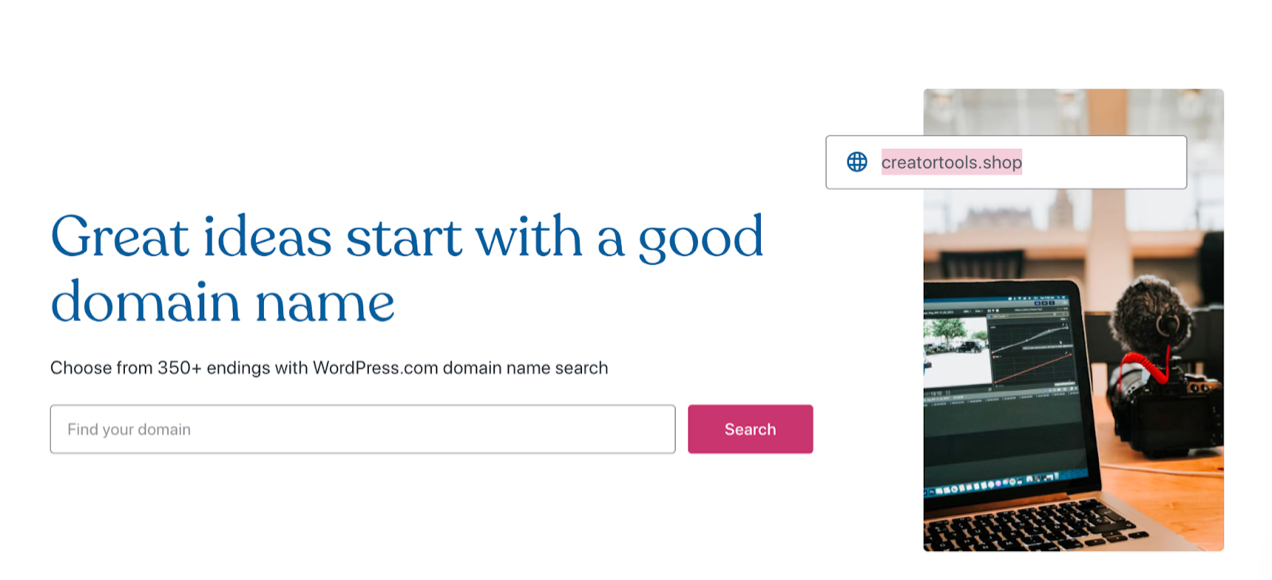
You also want your URL to be easy to spell and understand — if you say it out loud to a potential customer, they should be able to remember and type it into their browser later.
Learn more about how to choose a domain name.
Purchase web hosting
You’ll need a web hosting service to store your website files and make them available for people to view online. There are a variety of factors to consider here, including pricing, uptime, security offerings, and scalability.
Learn more about choosing a host and see our recommended hosting providers.
Choose an ecommerce platform
Your ecommerce tool provides the functionality you need to list products online, accept payments, and more. WooCommerce is an excellent choice for beginners and experts alike. It’s the ecommerce leg of WordPress, a website building tool that powers 43% of the web.
WordPress and WooCommerce stands above other platforms because they’re:
- Free to use. Both WordPress and WooCommerce offer all of their core functionality for free. While you can purchase premium add-ons, many stores can get started and run their business at no cost.
- Flexible and extendable. There are no limits! Have as many products and variations as you’d like. Sell any type of product, from physical and digital products to subscriptions, bookings, and courses. Design a website that fits with anything you can imagine.
- Open-source. Since both WordPress and WooCommerce are open-source, anyone can copy, modify, and change the code however they’d like. This means that there’s a high level of transparency and flexibility. It also means that there aren’t many of the restrictions and limits that come with proprietary platforms.
- Easy to use. These platforms were designed so that anyone can build a beautiful, effective site, even with no coding experience at all. For example, the powerful block editor lets you create pages by simply dragging and dropping elements (blocks) and configuring settings.
- Scalable. Again, there are no limits on the number of products, variations, or visitors your site can have. WooCommerce can be used to run small shops, all the way up to enterprise-level stores.
- Part of a tight-knit community. The WordPress and WooCommerce community is like no other, with meetups, Facebook groups, Slack channels, support forums, and more. It’s full of like-minded people who want everyone to find success!
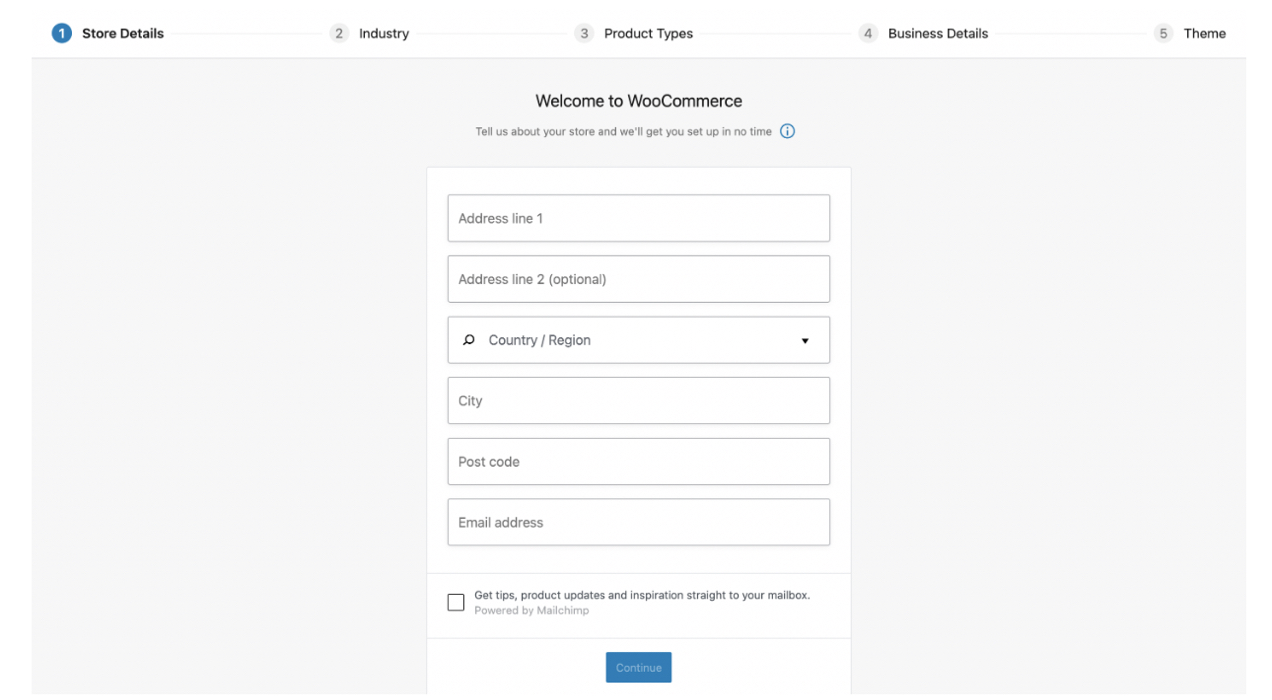
Most hosting providers offer one-click installation for WordPress, and WooCommerce includes a setup wizard that simplifies the getting started process.
Design your website
You’ll want to start this process by choosing a theme. This helps establish the design and layout of your site. There are lots of both free and premium themes available, and they vary based on how involved you want to be. Some are very plug-and-play, while others are more like frameworks for your design. Learn more about how to choose a WooCommerce theme.
Then, you can get to work on designing the rest of your website. Stick with the branding decisions you made earlier, like your logo and color palette, so that your entire online presence is cohesive. You can use the block editor to design everything from pages and product galleries to headers and product templates (if you’re using a block theme).

For an ecommerce store, you’ll likely need a homepage, About page, and Contact page, alongside product category, Cart, and Checkout pages. Again, this will vary based on your business.
Create your products
Now, you’ll want to create your product listings. By default, WooCommerce allows you to create:
- Simple products (Basic products without choices)
- Variable products (Items with options, like colors and sizes)
- Downloadable products (Products that customers can download)
- Virtual products (Items that aren’t physical, but aren’t downloaded, like a service)
You can also use extensions to offer everything from bookings and subscriptions to memberships and courses.
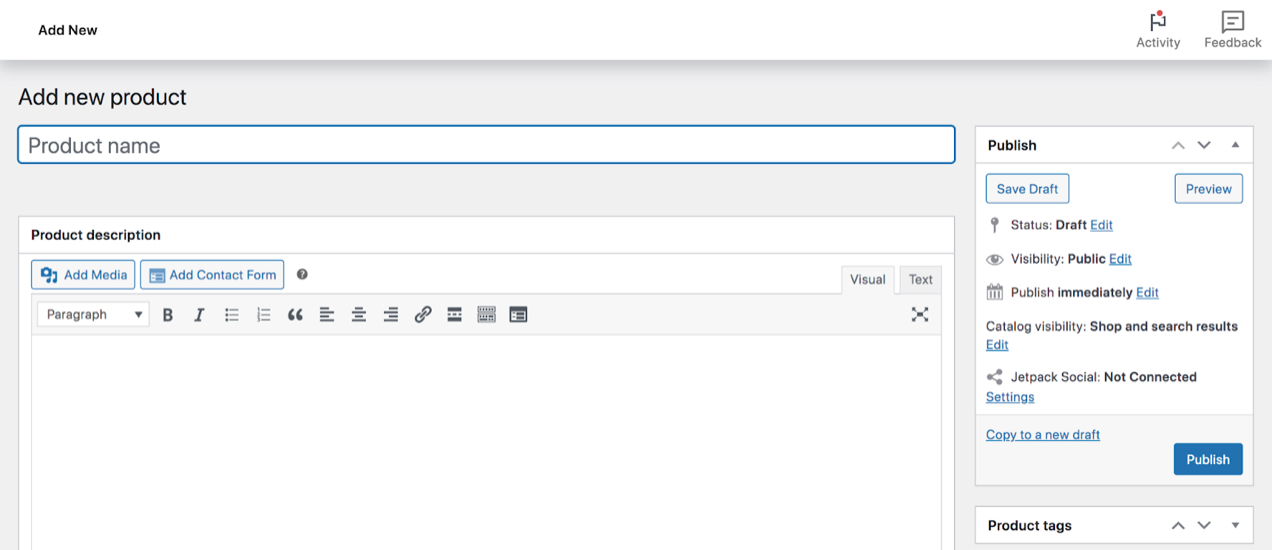
One major consideration when creating products is the photos that you use. Whether you sell physical or digital products, you’ll need photos. For digital products, these could be the cover to an eBook or the software packaging. Or if it’s an online course, create a graphic to represent the course. Learn how to take professional product photos.
You’ll also need to think through your product descriptions. Without a physical storefront and brand representatives able to showcase product offerings and answer questions, the descriptions and photos on your products take center stage. Writing your ecommerce product descriptions is not a place to skimp.
Yes, you need to provide all of the technical specifications, material info, etc. You should also consider what questions customers are going to ask and try to answer them within the description.
But moreover, you need to help paint a picture of how the features of what you’re offering will benefit customers in their life, work, play, etc.
Set up a payment gateway
A payment gateway allows you to securely collect payments for your items, then transfers that money to your business bank account. There are a few considerations to make here, but ultimately the gateway that you choose will depend on your business needs.
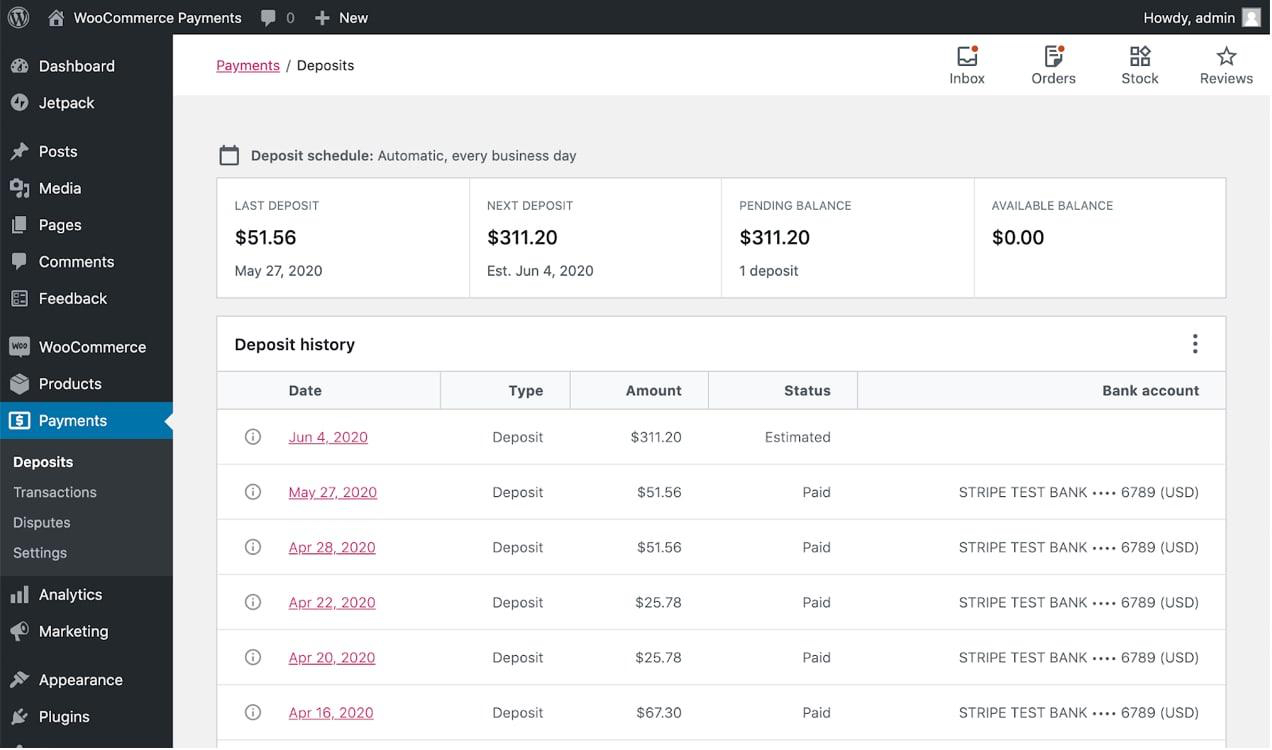
An excellent option is the free WooPayments extension. Built by WooCommerce, it integrates seamlessly with your store, keeping your customers on-site to pay. Plus, you can manage everything from your WordPress dashboard, offer additional payment methods like Apple Pay, and accept more than 135 currencies.
Learn more about choosing a payment gateway.
For even more details about building your WooCommerce store, read our post on how to start an online business.
Set up business systems and operations
Maximizing your margins as a business means focusing on efficiency and setting up systems that are duplicatable and minimize the need to continually come up with new solutions for your business model.
Will you be shipping products? If so, are you shipping them yourself from your own supply of inventory? Using a fulfillment company? Or maybe you’re dropshipping. Whichever approach you use, you have to get that system in place.

Determine packaging and shipping processes
You shouldn’t have to guess at packaging solutions every time a new order comes in. Set up an organized system for locating SKUs you have in stock and what’s required to safely pack each one for delivery. This should be a documented, organized process so that you could hire someone and at any point they could come in and take over this responsibility.
Some products need bubble wrap. Others can go in a polybag. Still some combinations require a box and should get a free sticker. These are all things to consider and document before you start to sell online.
Determine shipping materials
You’ll need a variety of packaging materials to ship orders of varying quantities and fragility. See more packaging tips.
Choose shipping partners and how you’ll charge for shipping
Who will ship your items based on their contents and any unique challenges? Not every carrier goes to every destination or works with every kind of material. You’ll also want to think through how you charge for shipping. Will you base it on weight? Offer a flat rate? Offer free shipping? Learn more in our shipping guide.
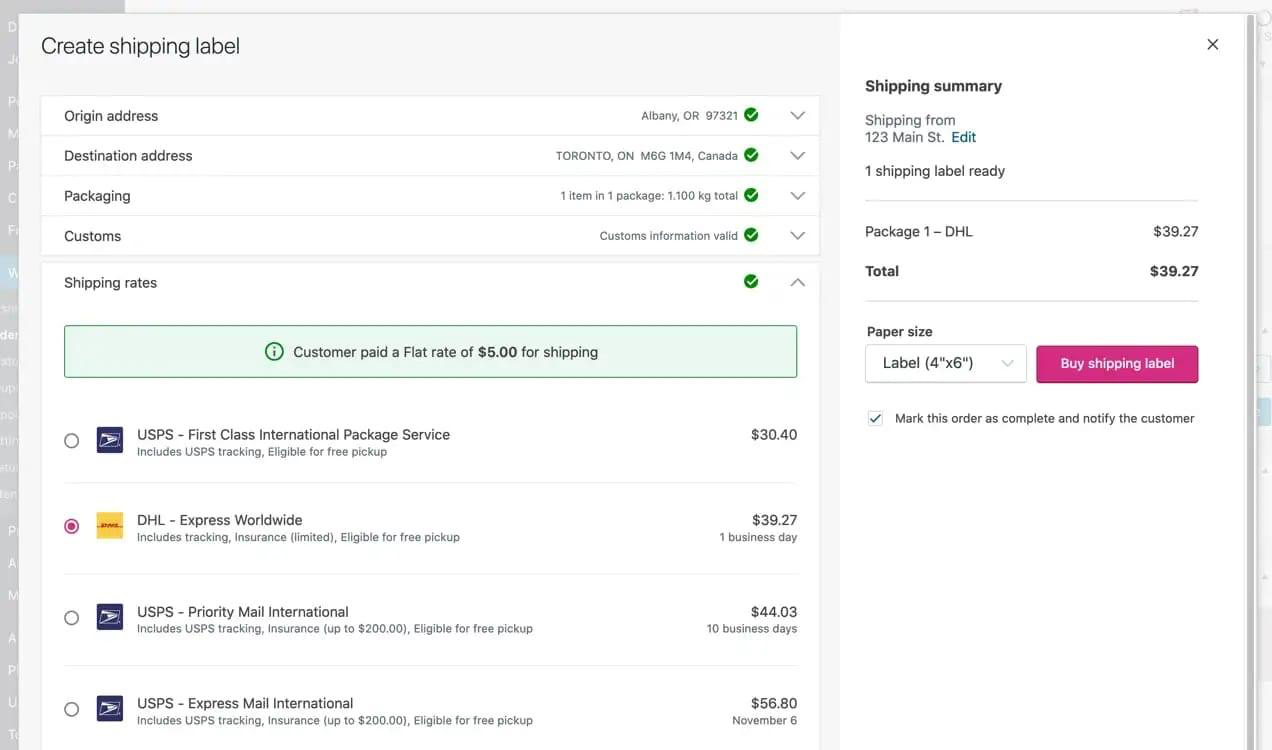
WooCommerce Shipping is an excellent, free extension to get you started. You’ll get access to discounted shipping rates from USPS and DHL, and be able to print labels right from your dashboard.
Determine inventory management and storage
Without proper inventory management, you’ll run into a slew of headaches. You can’t sell what you don’t have, so you want to keep enough products on-hand without risking a warehouse full of unsold goods.
If you’re going to pack and ship items you have on-hand, you’ll need a place to store the goods as well as anything needed to protect them and organize them for quicker fulfillment (bins, tubs, shelves, etc.).
And inventory management solutions can help you track the status of items and forecast what you’ll need in the future.
Think through customer service processes
How will questions be handled? What avenues will customers have to reach out? Is there a standardized procedure you can develop to handle issues at varying scales of severity?
Set up taxes and financial tracking
Most jurisdictions require the tracking and collection of some sort of sales tax or VAT. This can vary based on the origin of the customer, the shipping destination, the location of your store or physical inventory, and more. It can get complicated quickly.
In addition to tax implications, as a business owner, you should know your financial standing at any given time. And with numerous categories of expenses, and a wide variety of responsibilities on your shoulder, it can be a lot to take care of.
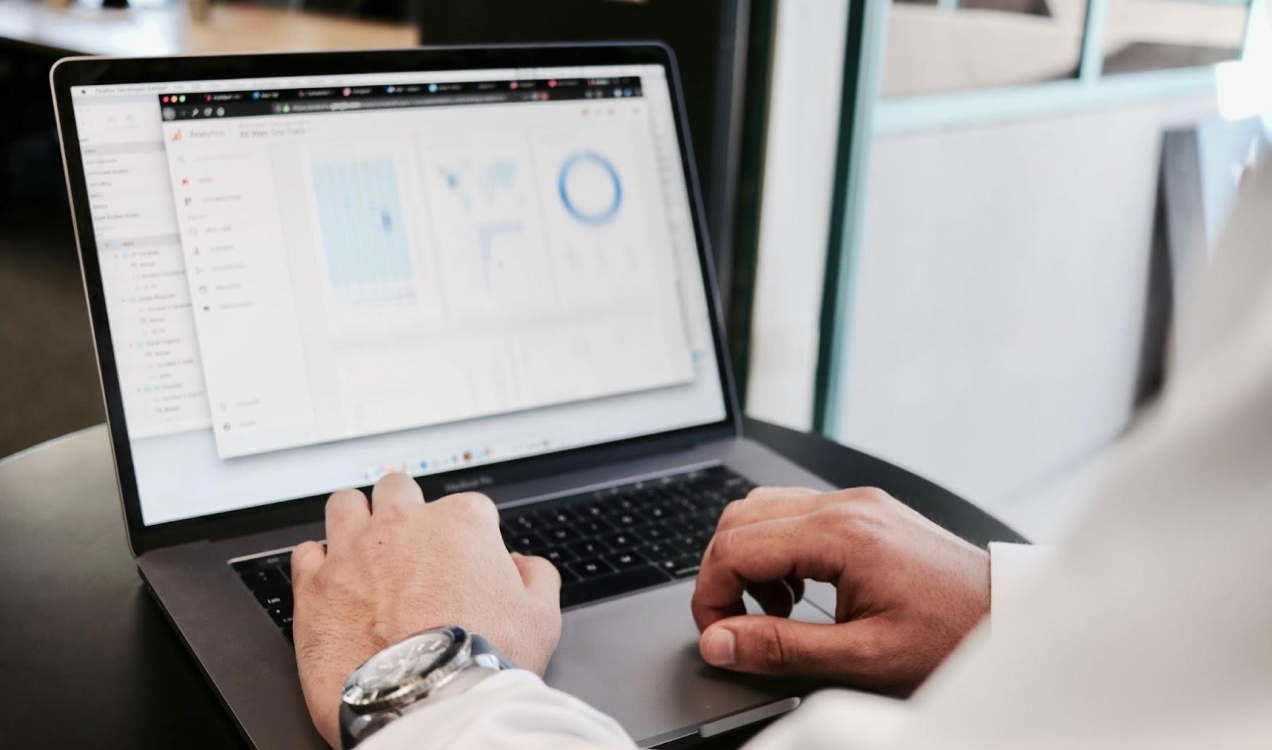
Thankfully, if you’re not a financial expert, choosing an ecommerce solution like WooCommerce takes away these headaches with helpful tax and accounting extensions that can automatically track and organize the information you need.
At tax time, or the appropriate interval of your choosing, simply send your financial professional this information and let them run with it from there.
Create return policies
It’s important that you take the time to outline effective and clear return policies. Create a policy that’s appropriate for your type of business, product, and customer base, and make it easily accessible on your website. For example, you might want to include it in the footer, where online shoppers can see it on every page.
Marketing
Just because you’ve created the best products to sell online and up a great ecommerce website doesn’t mean anyone will find it, let alone buy anything. Most marketers, as well as smart business owners, will tell you that every business is in the marketing business. Your business is to sell your products, and that’s marketing. Before you can find your place by offering the highest quality, most unique, or best-priced items, people have to hear about, understand, and be motivated to buy.
Marketing is foundational to every business and it’s for this reason that many of the core marketing principles in this section can, and should, be developed in tandem with other aspects of this checklist. Your audience and how you want to present your business should impact everything from your company name and website to which SKUs to develop.
Define and learn about your target audience
Are you selling to a particular demographic such as kids, parents, singles, retired people? Are you selling to another business niche? Perhaps you’re selling based on interests, like rock climbing or landscaping. You might be selling based on some sort of need.
But even with needs, other factors come into play. We all need to eat. We all need to wear clothes. But which food and clothes we choose depends a lot on personal preference, culture, life experience, how we were raised, financial capacity, etc.
Your audience determines your product to some degree, and your product determines your audience. You must consider both at the same time.
Once you’ve defined who your potential customers are, your marketing should reflect that and call that audience out. For instance, if you’re selling landscaping service to retirees, your marketing should make it clear your service is meant for retirees, not just anyone. If you’re selling landscaping to retirement communities, that’s a different audience.
Go further: How to identify and learn about your target audience.
Determine how you will reach that audience
Next, how will you reach your target market? Will you primarily use digital marketing? Or will you use print or in-person marketing as well? Your target audience again will determine the answer to some degree.
For instance, using the previous example, many retirees may not be on TikTok, so it wouldn’t make much sense for that business to direct all of your ad spend to that platform. But a business selling makeup to teens and college students might want to strongly consider advertising on TikTok or other social media channels.
Where is your audience? How do they shop? Where do they look for solutions to the problems your product solves? How else can you get their attention?

Decide on an initial marketing budget
Every online business must decide their initial marketing costs based on their unique situation. You must consider:
- Your available finances to invest up front
- The cost of various marketing channels
- What you will do yourself and what you will outsource
- The value of your product
A product that sells for $500 deserves a larger marketing budget than one selling for $5. At least at first. But if the $5 item becomes a big seller, you can increase the marketing spend for that later.
It takes a lot more money to create a TV commercial than an email marketing campaign. But you have to have an email list to mail to, and that requires additional marketing efforts. Direct mail requires a list, too.
In-person events charge fees to buy a booth. Pay-per-click (PPC) online marketing charges for each click.
You have to determine how much you’re willing to spend — initially — to attract, engage, and convert your first set of customers. As you start to grow, your strategies and investments will change.
Begin your digital marketing
As an online business, you’re going to need digital marketing. How to sell online is a huge topic, but for now your task is to decide where you want to get started. Your options include:
- Email marketing
- Social media marketing, with multiple platforms to choose from
- PPC marketing, which includes Google Shopping, a good option for ecommerce stores
- Display marketing
- Search engine optimization
Each of these entails a learning curve and an investment of time and money. You cannot do them all from the start.
Search engine optimization has the lowest cost if you do it yourself, but requires a lot of time to understand, research, and execute. But if you have the time, start writing blog posts, eBooks, guides, checklists, infographics, and other digital marketing assets. Build them around what your audience cares about.
Then, use them to turn your website visitors into leads and customers. Ask them to join your email list with an opt-in form. That allows you to send email marketing messages that, again, you can choose to build yourself.
The other forms of marketing can cost more, but allow you to more quickly and effectively target your ideal customers, enabling you to build up your business faster.
Consider in-person marketing strategies
The biggest obstacle of digital marketing is all the other digital marketing out there. The online world is full of distractions. Sometimes, a better approach is to just get out there and meet people in person.

Get a booth at an industry event. Try getting a speaking slot and engage your audience from a position of authority. Run your own event for your target audience, much like some financial advisors do. Go to networking events. Join a local chamber of commerce.
With WooCommerce In-Person Payments, you can even sell inventory directly at events like farmers markets or trade shows. Those sales will sync with your WooCommerce accounting and inventory numbers automatically.
The value of doing things like this goes far beyond immediate sales. You’ll learn a lot with each new interaction. You will learn better ways to present yourself and your products.
Consider printed marketing strategies
Print marketing includes direct mail, which can be postcards, letters, and flyers. You can also write books, small guides, and brochures.
You can use these to drive traffic to your online store by including your website or a specific landing page URL on the printed materials. The dedicated landing page strategy works well because you can track how many people use it, and know how well that strategy is working for you.
Grab your checklist and start working through it today
Starting an online business can involve quite a few steps, but they’re well worth it! And WooCommerce is here to help, with all the tools you need to build and run an online store.
Ready to go? Get started with WooCommerce today.
